Bronx Zoo Says Bye-Bye to Non-Celebs
Posted by: Loren Coleman on April 26th, 2009

If you happen to live in the New York City area or have a forthcoming visit there, you might wish to plan on going to the Wildlife Conservation Society’s Bronx Zoo, sooner than later.

Remember, the Bronx Zoo’s unassumingly herd of bison was responsible for bringing the whole species back from extinction in the wild.
For cryptozoologists, we know it is often the truly unique and sometimes unnoticed or smaller species that can be as exciting as the big name lions, tigers, and bears, so often identified as “zoo animals.”
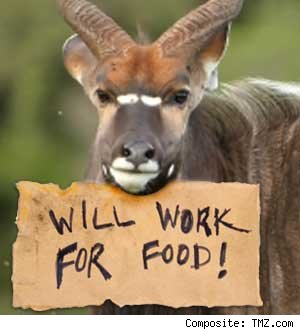
Due to the economy and required budget cuts, the Bronx zoo decided on April 24th to delete from its collection some rare, smaller, and what I must call “non-celebrity species.”
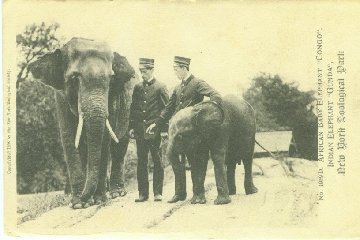
New York City’s Bronx Zoo, the largest metropolitan wildlife preserve in the United States, is dealing with a $15 million budget deficit and will be closing four exhibits and removing all their occupants, estimated to number in the hundreds of animals. The announced plan is that the animals will be relocated to zoos around the country, although it is a known fact that other zoos suffering harsh economy times have often quietly slaughtered their larger hoofed animals to be fed to predators, such as tigers.

Another old Bronx Zoo postcard. See Source D.
According to what can be gleamed from reports, the following animals will be gone soon from the Bronx Zoo collection.
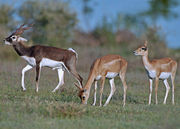
The zoo residents mentioned are among the following.
All the species will be removed from the soon-to-close “World of Darkness” exhibition of bats, porcupines, sugar gliders, and several primate species, including lesser galago (Galago senegalensis), as well as other lemurs, bush babies, and night monkeys.

The rocking stone (a “logan stone” actually) shown in this 1905 Bronx Zoo postcard is a 40 ton boulder of pink granite. The Rocking Stone restaurant can be seen in the background. The boulder was moved in 1959 to the “World of Darkness,” where it was moved slightly so it could no longer be rocked. Source D.
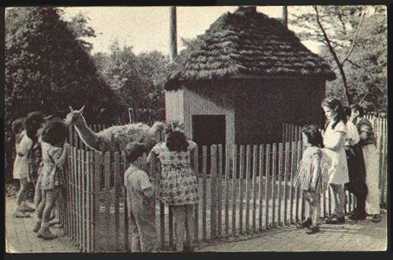
Bronx Zoo postcard from 1944 shows a llama and children.
All the animals in the “Rare Animal Range,” and another exhibit, including the Formosan deer (Cervus nippon or Cervus taiouanus), South American guanaco (Lama guanicoe), foxes, other lemurs, and caimans, are due to be eliminated from the zoo.
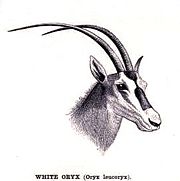
One other exhibit being closed includes that of the Arabian oryx and blesbok in the southeastern corner of the zoo. The Arabian oryx (Oryx leucoryx) and blesbok (Damaliscus dorcas phillpsi or Damaliscus pygargus), two types of antelope. An endangered species, the Arabian oryx was hunted to extinct in the wild by 1972; reintroduction programs have since been attempted, with mixed success. The Phoenix Zoo is credited with saving the Arabian Oryx from extinction, and has been instrumental in breeding the Arabian oryx back from the eve of complete extinction. The blesbok were first discovered in the 17th century, and were found in numbers so numerous that the South African wild herds once reached from horizon to horizon, but that is hardly the case today. The blesbok was nearly hunted to extinction due to their perceived large numbers.
So, get out your field guides and take a visit to the zoo, before all the real celebrities disappear.

Once again, I highly recommend Elizabeth Cary Mungall’s Exotic Animal Field Guide.
But wait….
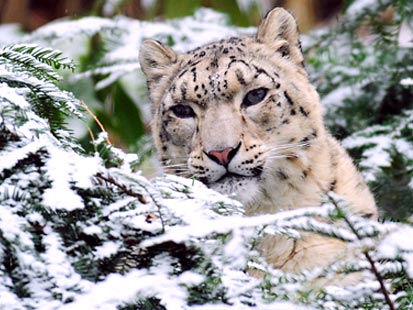
Quietly and with much less fanfare, the Bronx Zoo also concurrently announced, “In the immediate future, we will be opening exhibits with hyenas and aardvarks in the Bronx and snow leopards in Central Park.”
The photograph above is of a snow leopard taken at the Bronx Zoo.
This tends to reinforce my thoughts on “celebrity” vs “non-celebrity” species getting the nod in priority fiscal support decisions.
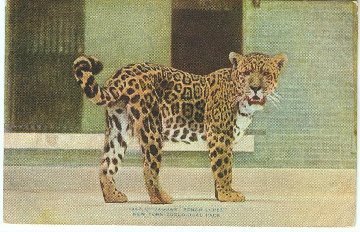
Keep us alive too….
About Loren Coleman
Loren Coleman is one of the world’s leading cryptozoologists, some say “the” leading living cryptozoologist. Certainly, he is acknowledged as the current living American researcher and writer who has most popularized cryptozoology in the late 20th and early 21st centuries.
Starting his fieldwork and investigations in 1960, after traveling and trekking extensively in pursuit of cryptozoological mysteries, Coleman began writing to share his experiences in 1969. An honorary member of Ivan T. Sanderson’s Society for the Investigation of the Unexplained in the 1970s, Coleman has been bestowed with similar honorary memberships of the North Idaho College Cryptozoology Club in 1983, and in subsequent years, that of the British Columbia Scientific Cryptozoology Club, CryptoSafari International, and other international organizations. He was also a Life Member and Benefactor of the International Society of Cryptozoology (now-defunct).
Loren Coleman’s daily blog, as a member of the Cryptomundo Team, served as an ongoing avenue of communication for the ever-growing body of cryptozoo news from 2005 through 2013. He returned as an infrequent contributor beginning Halloween week of 2015.
Coleman is the founder in 2003, and current director of the International Cryptozoology Museum in Portland, Maine.










SAD DAY!
I saw this on the news, as well.
It says something when even zoos are not immune from harsh economic climates.
I always liked seeing the tapirs at the zoo. That’s just me.
I guess they would be considered “non-celebs.”
The World of Darkness is my favorite part of the Bronx Zoo. Second to that is the gorilla experience. Which is a face to face with gorillas. I have been going to the Bronx Zoo since I was maybe 4 or 5. Used to be there every Wednesday during the summer. It’s terribly unfortunate that they have to close any exhibit in there, especially the World of Darkness. Now the only bats there will be the wild ones, and the ones in the Asia exhibit.
Greetings All!
WOW! On top of the wrongness of closing all those exhibits, releasing snow leopards into Central Park!! Is it to control the coyotes? Forest Park in St. Louis is two and a half times the size of Central Park, and I think it still would be small for a snow leopard home range! (Maybe we now know where the oryx, blesbok, deer etc will be going… )
I guess the zoos if the zoos have to focus on caring for fewer species in order to care for them well, I can understand why they focus on those that draw in the highest number of paying customers. But with so much habitat destruction in the world today, zoos are one of the few realistic hopes for the survival of many species. I personally prefer zoos with more diversity of life, and I like to see not only the spectacular, charismatic species, but also the lesser-knowns.
Still, if I had to choose between seeing a snow leopard and seeing a blesbok, the snow leopard would have my vote 🙂 . I just don’t like having to choose. Why not keep the existing exhibits, but not acquire any new animals for them, and so allow them to gradually phase out as animals live out their lives?
On the other hand, if there are zoos with good facilities elsewhere in the country which can take these animals and maintain them, then patrons of those zoos may have opportunities to see animals that they otherwise would not.
I have always been interested in less-known species, especially the odd ones.
“I wanna see the Elephants, mommy!”
you can see elephants at almost ANY zoo.
If I ever get the money, like the lottery (or government assistance or other people helping out or a huge loan), I’m going to attempt to start one someday nothing but rare, endangered, and forgotten species.
~yeah right~
it would still be a cool idea though….
Yes crapple, that has always been a dream of mine too.
I would love to see a modern, large, state-of-the art zoo here in eastern Kentucky. There is plenty of reclaimed land available, and it would bring in a lot of tourism. The closest large modern zoos are Cincinnati, Louisville, Columbus, and Knoxville – all more than 100 miles away. It would draw local visitors from West Virginia, southwestern Ohio, Virginia, and Tennessee, as well as from Kentucky. Plus, it would bring jobs – good jobs, and most importantly, jobs unrelated to the coal mining industry.
I also would love to see some more conservation facilities built along the lines of The Wilds, which is a breeding facility for endangered wildlife built on reclaimed strip-mine land in southwestern Ohio. Some of these less charismatic, but just as important, lesser-known species could be maintained in such facilities.
The blesbok is far from extiction and was never hunted to the verge of extiction, this was done to its cousin the Bontebok, unless you know how it is very difficult for the two to be told apart. The Blesbok was discovered long after the Bontebok as its range was mainly in the Western Cape and along the coastal areas, the Blesbok was discovered much later as it is more of plains species and found further inland. In South Arica where both the Blesbok and Bontebok are endemic, there are still big herds of Blesbok on most farms and reserves, although not nearly near the numbers previously recorded, they are a hardy species and have been moved to game farms all over the country where they are doing quite well, they seem to be able to survive anything, unlike the Bontebok where there are only 3 pure recognised herds in the country and which are not nearly as hardy as the Blesbok. One of the downfalls of the Bontebok has been cross breeding with the Blesbok where they have been introduced by farmers into the Bontebok range. For many years these two where considered the same animal, thus due to the number of Blesbok it was never considered that the Bontebok would become endangered or nearly exticnt. Three animals fall into this family group, Bontebok, Blesbok and Tessebbe
The Blesbok along with the Impala are the main species hunted by hunters in South Africa and thier numbers never dwindle. Along with Springbuck, Blesbok meat is commercially sold all over the world and particularly in Europe. Its commercial value today is high enough to ensure it a long a future
Kolobe, the present status of a species is no indication of historical events. According to the history of the blesbok alone, I sense we are viewing two different sources. It was the captivity of blesboks and bonteboks that appears to have recovered both species from near extinction, historically.
The blesbok (Damaliscus pygargus phillipsi) were first discovered in the 17th century. Indeed, because of the confusion between blesbok and bontebok, they appear to both be credited as to have been discovered and labeled as two species with the original name
Antilope pygargus (Pallas, 1767), Cape Province, South Africa.
“The blesbok ranged the treeless Highveld in countless thousands throughout the mid-19th century but was hunted nearly to extinction….An isolated related subspecies, the bontebok (Damaliscus pygargus dorcas), confined to the coastal plain of Western Cape province, came nearer to extinction and is still uncommon.” ~ Britannica Encyclopedia
The bontebok (Damaliscus pygargus) was first described after discovery by Pallas in 1767.
“The Bontebok was historically confined to the coastal plain (60-200 m) of the Western Cape, South Africa, where overhunting reduced it from locally abundant to the verge of extinction.” ~ IUCN 2008 Red List
“The blesbok is Lower Risk/Conservation Dependent. Its distribution is largely artificial and it occurs in protected herds on fenced reserves and farms. The bontebok is Vulnerable. It was hunted almost to extinction in the nineteenth century, but was saved by protection from a few enlightened farmers. After the establishment of the Bontebok National Park in 1931, numbers increased and stocks were introduced to other farms and reserves.” ~ Animal Encyclopedia, Answers.com